Latest Cisco 500-220 Dumps for success in Actual Exam Mar-2024]
Realistic 500-220 100% Pass Guaranteed Download Exam Q&A
NEW QUESTION # 11
Refer to the exhibit.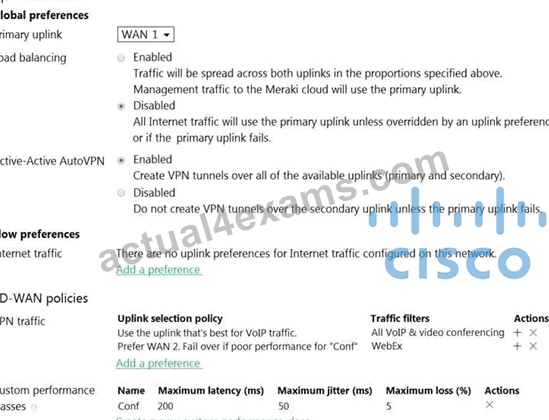
Assuming this MX has established a full tunnel with its VPN peer, how will the MX route the WebEx traffic?
- A. WebEx traffic will prefer WAN 1 as it is the primary uplink.
- B. WebEx traffic will be load-balanced between both active WAN links.
- C. WebEx traffic will prefer WAN 2 as long as it is up.
- D. WebEx traffic will prefer WAN 2 as long as it meets the thresholds in the "Conf" performance class.
Answer: D
Explanation:
Explanation
Assuming this MX has established a full tunnel with its VPN peer, the MX will route the WebEx traffic based on the SD-WAN policy configured in the exhibit. The SD-WAN policy has two performance classes: Conf and Default. The Conf performance class matches the traffic with destination port 9000, which is used by WebEx for VoIP and video RTP3. The Conf performance class has a preferred uplink of WAN 2 and a failover uplink of WAN 1. It also has thresholds for latency, jitter, and loss that determine when to switch from the preferred uplink to the failover uplink. Therefore, the WebEx traffic will prefer WAN 2 as long as it meets the thresholds in the Conf performance class. If WAN 2 exceeds the thresholds or goes down, the WebEx traffic will switch to WAN 1 as the failover uplink.
NEW QUESTION # 12
What are two ways peers interact with ports that Auto VPN uses? (Choose two.)
- A. For IPsec tunneling, peers use high UDP ports within the 32768 to 61000 range.
- B. For IPsec tunneling, peers use high TCP ports within the 32768 to 61000 range.
- C. Peers contact the VPN registry at TCP port 9350.
- D. For IPsec tunneling, peers use UDP ports 500 and 4500.
- E. Peers contact the VPN registry at UDP port 9350.
Answer: A,E
Explanation:
Explanation
Ports used to contact the VPN registry:
- Source UDP port range 32768-61000
- Destination UDP port 9350 or UDP port 9351
Ports used for IPsec tunneling:
- Source UDP port range 32768-61000
- Destination UDP port range 32768-61000
https://documentation.meraki.com/MX/Site-to-site_VPN/Meraki_Auto_VPN_-_Configuration_and_Troubleshoo
NEW QUESTION # 13
How is high-availability supported for Cisco Meraki devices?
- A. Only the MX Security Appliances that use VRRP support high availability.
- B. The MX Security Appliances and MS Series Switches that use VRRP support an active/passive high- availability pair.
- C. The MX Security Appliances and MS Series Switches that use HSRP support an active/passive high- availability pair.
- D. An active/active high-availability pair is recommended for MX Security Appliances.
Answer: B
Explanation:
Explanation
https://documentation.meraki.com/MS/Layer_3_Switching/MS_Warm_Spare_(VRRP)_Overview
NEW QUESTION # 14
What is the best practice Systems Manager enrollment method when deploying corporate-owned iOS devices?
- A. manual
- B. Sentry enrollment
- C. Apple Configurator
- D. DEP
Answer: D
Explanation:
Explanation
iOS devices that are using Apple's Device Enrollment Program (DEP) can be supervised and enrolled over-the-air anytime they are factory reset. DEP is the best way to permanently force your devices to be owned and managed by your organization, and it is important to assign your DEP settings properly before deployment.
https://documentation.meraki.com/SM/Device_Enrollment/Enrolling_and_Supervising_iOS_Devices_using_App
NEW QUESTION # 15
Which two actions can extend the video retention of a Cisco Meraki MV Smart Camera? (Choose two.)
- A. enabling maximum retention limit
- B. configuring a recording schedule
- C. enabling motion-based retention
- D. enabling audio compression
- E. installing an SSD memory extension
Answer: B,C
Explanation:
Explanation
https://documentation.meraki.com/MV/Advanced_Configuration/Scheduled_Recording By default, the Meraki security camera's will record continuously 24/7. In some situations, certain times of day are not allowed to be recorded. Scheduled recording covers this requirement as well as improve the video retention capabilities of the camera.
NEW QUESTION # 16
Which information do the MXs in a High Availability pair share?
- A. spanning-tree state
- B. DHCP association database
- C. time synchronization state
- D. stateful firewall database
Answer: A
NEW QUESTION # 17
Which three verbs of request are available in the Cisco Meraki API? (Choose three.)
- A. ADD
- B. GET
- C. SET
- D. PATCH
- E. PUT
- F. POST
Answer: B,E,F
Explanation:
Explanation
Verbs in the API follow the usual REST conventions:
GET returns the value of a resource or a list of resources, depending on whether an identifier is specified.
POST adds a new resource
PUT updates a resource
DELETE removes a resource
https://documentation.meraki.com/General_Administration/Other_Topics/Cisco_Meraki_Dashboard_API
NEW QUESTION # 18
There will be 100 concurrent users streaming video to their laptops. A 30/70 split between 2.4 Ghz and 5 Ghz will be used. Roughly how many APs (rounded to the nearest whole number) are needed based on client count?
- A. 0
- B. 1
- C. 2
- D. 3
Answer: A
Explanation:
Explanation
This is the approximate number of APs that are needed based on client count, assuming that each AP can support up to 25 concurrent video streaming users. This can be calculated by using the formula:
Number of APs = (Number of Users x Percentage of Users on a Band) / Number of Users per AP on that Band Where Number of Users is 100, Percentage of Users on 2.4 Ghz is 30%, Percentage of Users on 5 Ghz is 70%, Number of Users per AP on 2.4 Ghz is 15, and Number of Users per AP on 5 Ghz is 30. Therefore, Number of APs = (100 x 0.3 / 15) + (100 x 0.7 / 30) Number of APs = (3.33) + (2.33) Number of APs = 5.66 Rounding to the nearest whole number, the number of APs is 4.
This question is related to the topic of Wireless Capacity Planning in the Cisco Meraki documentation. You can find more information about this topic in the [Wireless Capacity Planning] article or the [Best Practice Design - MR Wireless] page.
NEW QUESTION # 19
Which requirement is needed to implement Fast Lane on Cisco Meraki APs?
- A. adaptive 802.11r disabled
- B. wireless profile installed on a Cisco iOS access point
- C. traffic shaping rule tagging traffic with a DSCP value of 46 to Apple.com
- D. wireless profile installed on an Apple iOS device
Answer: D
Explanation:
Explanation
Meraki MR Access Points, in combination with a wireless profile installed on the iOS device, will enable the Fast Lane technologies. The fastest way to install a wireless profile on an iOS device is via Meraki EMM.
https://documentation.meraki.com/MR/Wi-Fi_Basics_and_Best_Practices/Wireless_QoS_and_Fast_Lane
NEW QUESTION # 20
How does a Meraki device behave if cloud connectivity is temporarily lost?
- A. The offline device reboots every 5 minutes until connection is restored.
- B. The offline device stops passing traffic.
- C. The offline device continues to run with its last known configuration until cloud connectivity is restored.
- D. The offline device tries to form a connection with a local backup sever.
Answer: C
Explanation:
Explanation
What happens if a network loses connectivity to the Meraki cloud?
Because of Meraki's out of band architecture, most end users are not affected if Meraki wireless APs, switches, or security appliances cannot communicate with Meraki's cloud services (e.g., because of a temporary WAN failure):
* Users can access the local network (printers, file shares, etc.)
* If WAN connectivity is available, users can access the Internet
* Network policies (firewall rules, QoS, etc.) continue to be enforced
* Users can authenticate via 802.1X/RADIUS and can roam wirelessly between access points
* Users can initiate and renew DHCP leases
* Established VPN tunnels continue to operate
* Local configuration tools are available (e.g., device IP configuration
https://meraki.cisco.com/lib/pdf/meraki_datasheet_cloud_management.pdf
NEW QUESTION # 21
Refer to the exhibit.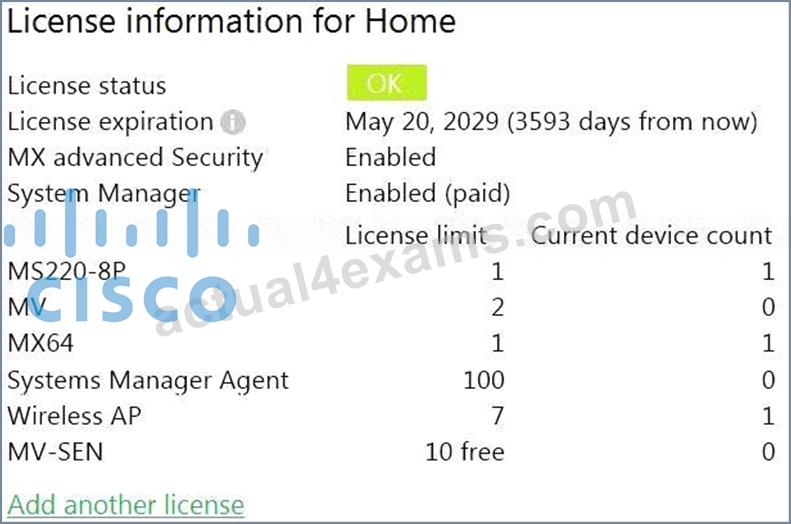
This Dashboard organization uses Co-Termination licensing model.
What happens when an additional seven APs are claimed on this network without adding licenses?
- A. All APs stop functioning in 30 days.
- B. One AP Immediately stops functioning.
- C. All APs immediately stop functioning.
- D. All network devices stop functioning in 30 days.
Answer: D
Explanation:
Explanation
The number of devices in an organization can not exceed the license limits. If this occurs, the organization will enter a 30-day grace period, during which the organization must be brought back into compliance, otherwise it will be shut down until proper licensing is applied to the organization.
https://documentation.meraki.com/General_Administration/Licensing/Meraki_Co-Termination_Licensing_Overv
NEW QUESTION # 22
Air Marshal has contained a malicious SSID.
What are two effects on connectivity? (Choose two.)
- A. Currently associated clients stay connected.
- B. New clients can connect.
- C. Currently associated clients are affected by restrictive traffic shaping rules.
- D. New clients cannot connect.
- E. Currently associated clients are disconnected.
Answer: D,E
NEW QUESTION # 23
What is out of scope when considering the Best practices for high-density wireless designs?
- A. maximum beamforming
- B. band selection
- C. number of SSIDs
- D. minimum bitrate
Answer: A
Explanation:
Explanation
https://documentation.meraki.com/Architectures_and_Best_Practices/Cisco_Meraki_Best_Practice_Design/Best
NEW QUESTION # 24
Refer to the exhibit.
Which outcome occurs when logging is set to Enabled?
- A. Inbound flows are sent to a configured syslog server if a syslog server configured for flows.
- B. The hits counter within this section is now enabled.
- C. This firewall rule is now enabled.
- D. Outbound flows are sent to a configured syslog server if a syslog sender is configured for flows.
Answer: A
NEW QUESTION # 25
Drag and drop the descriptions from the left onto the permission types on the right.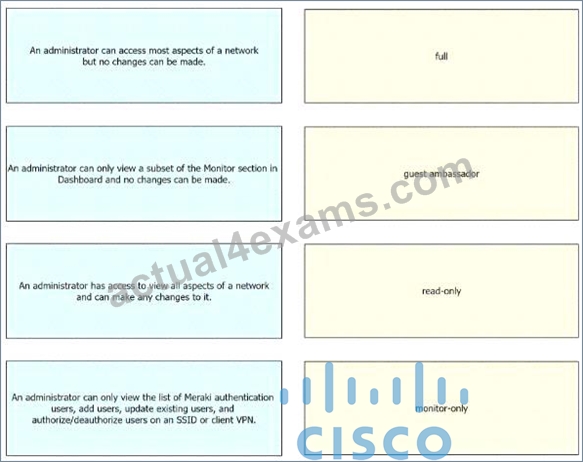
Answer:
Explanation: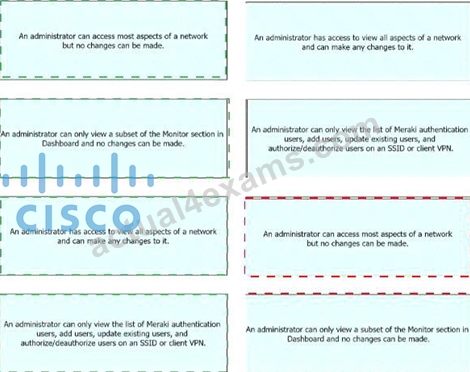
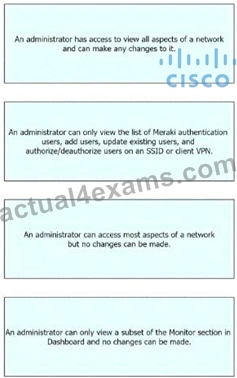
NEW QUESTION # 26
What are two roles of the network and device tags in a Dashboard? (Choose two.)
- A. Tags enable administrators to configure a combination of network and device specific tags to create summary reports filtered for specific devices across multiple networks.
- B. Device tags can be assigned to MR APs to influence the gateway selection for repeaters in a mesh wireless network.
- C. Network tags can be used to assign networks to separate Auto VPN domains in an Organization with many networks.
- D. Network tags can be used to simplify the assignment of network-level permissions in an Organization with many networks.
- E. Device tags can be used to simplify the assignment of device-level permissions in an Organization with many administrators.
Answer: A,B
Explanation:
Reference:
Organization_Menu/Manage_Tags
NEW QUESTION # 27
Which Meraki Dashboard menu section is accessed to enable Sentry enrollment on an SSID?
- A. Wireless > Configure > Splash page
- B. Wireless > Configure > Firewall & Traffic Shaping
- C. Wireless > Configure > Access Control
- D. Wireless > Configure > SSIDs
Answer: C
Explanation:
Explanation
SM Sentry enrollment can be enabled on any MR network via the Splash page section of the Wireless > Configure > Access control page.
https://documentation.meraki.com/MR/MR_Splash_Page/Systems_Manager_Sentry_Enrollment
NEW QUESTION # 28
For which two reasons can an organization become "Out of License"? (Choose two.)
- A. licenses that are in the wrong network
- B. MR licenses that do not match the MR models in the organization
- C. licenses that do not match the serial numbers in the organization
- D. expired device license
- E. more hardware devices than device licenses
Answer: D,E
NEW QUESTION # 29
Refer to the exhibit.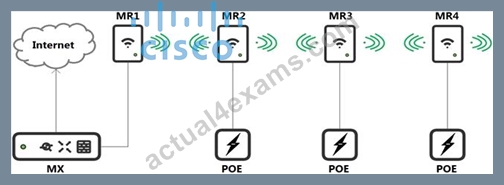
Which design recommendation should be considered?
- A. A 25-percent throughput loss occurs for every hop. Cisco Meraki best practice recommends a 1-hop maximum.
- B. A 50-percent throughput loss occurs for every hop. Cisco Meraki best practice recommends a 1-hop maximum.
- C. A 50-percent throughput loss occurs for every hop. Cisco Meraki best practice recommends a 2-hop maximum.
- D. A 25-percent throughput loss occurs for every hop. Cisco Meraki best practice recommends a 2-hop maximum.
Answer: A
NEW QUESTION # 30
Refer to the exhibit.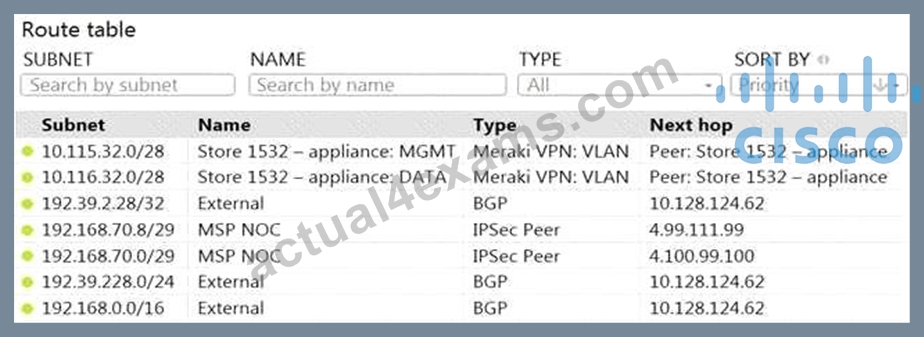
A packet arrives on the VPN concentrator with source IP 10.168.70.3 and destined for IP 10.116.32.4.
What is the next hop for the packet, based on this concentrator routing table?
- A. The concentrator gateway (10.128.124.62) is the next hop.
- B. The packet is stopped.
- C. The Auto VPN peer "Store 1532 - appliance" is the next hop.
- D. Not enough detail is available to determine the next hop.
Answer: C
Explanation:
Explanation
This can be determined by looking at the concentrator routing table and finding the entry for the destination IP
10.116.32.4. The next hop for this entry is the Auto VPN peer "Store 1532 - appliance".
This question is related to the topic of Implementing Dynamic Routing Protocols in the Engineering Cisco Meraki Solutions (ECMS) official training documentation. You can find more information about this topic in the ECMS v2.2 Course Overview or the ECMS1 v2.1 Course Overview.
NEW QUESTION # 31
A Cisco Meraki MV camera is monitoring an office and its field of vision currently captures work desks and employee computer screens. However, recording employee computer screens is prohibited by local regulation.
Which feature in Dashboard can be used to preserve the current position of the camera while also meeting regulation requirements?
- A. area or interest
- B. privacy window
- C. sensor crop
- D. zone exclusion
- E. restricted mode
Answer: E
NEW QUESTION # 32
Refer to the exhibit.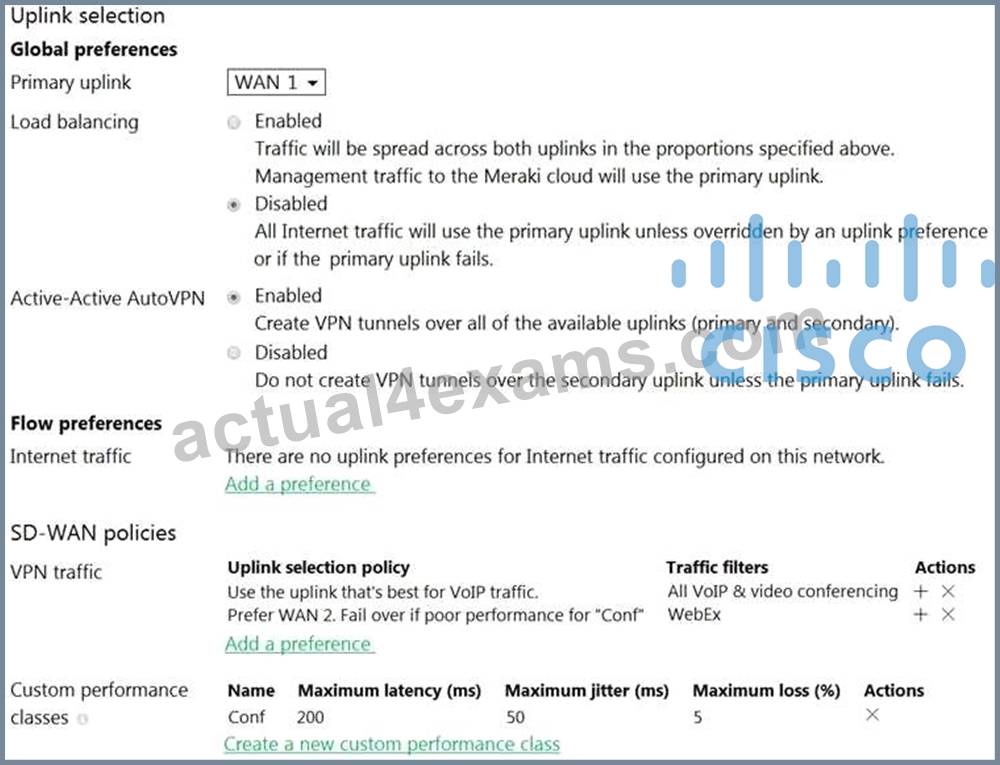
Assuming this MX has established a full tunnel with its VPN peer, how will the MX route the WebEx traffic?
- A. WebEx traffic will prefer WAN 2 as long as it meets the thresholds in the "Conf" performance class.
- B. WebEx traffic will be load-balanced between both active WAN links.
- C. WebEx traffic will prefer WAN 1 as it is the primary uplink.
- D. WebEx traffic will prefer WAN 2 as long as it is up.
Answer: C
NEW QUESTION # 33
Which configuration step is necessary when automatic updating is required of iOS apps provisioned through Systems Manager that are found in the App Store?
- A. Configure automatic updating of iOS devices in the Meraki installed profile.
- B. Create a profile with automatic update enabled and apply it to iOS devices.
- C. Create a security policy that enables automatic updates.
- D. No configuration step is necessary; automatic updating is the default behavior.
Answer: C
NEW QUESTION # 34 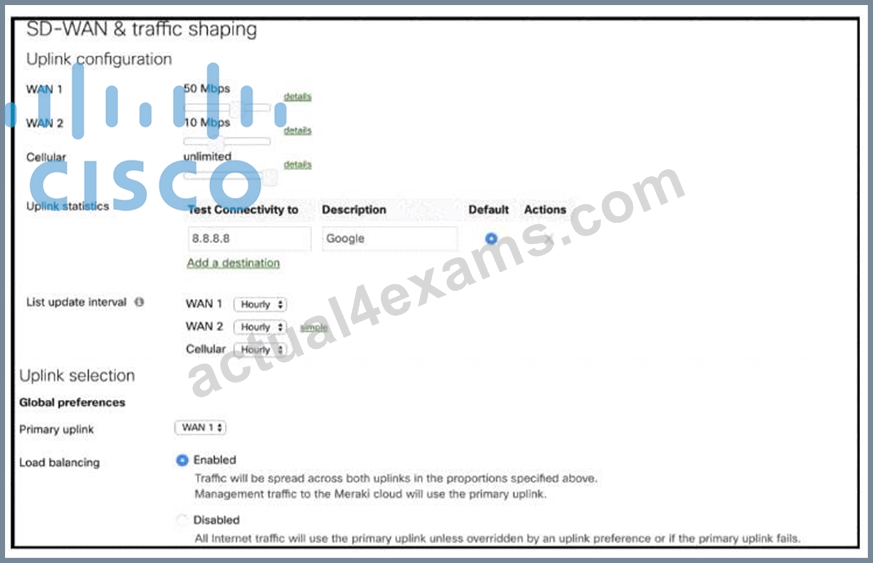
Refer to the exhibit. What Is the ratio of internet-bound flows that route via WAN 1 compared with WAN 2?
- A. All flows alternate in a 5:1 ratio.
- B. All flows alternate in a 2:1 ratio.
- C. All flows egress via WAN1.
- D. All flows agrees via WAN 1:1 ratio.
Answer: D
Explanation:
Explanation
https://documentation.meraki.com/MX/Firewall_and_Traffic_Shaping/MX_Load_Balancing_and_Flow_Prefere
NEW QUESTION # 35
......
Accurate 500-220 Answers 365 Days Free Updates: https://www.actual4exams.com/500-220-valid-dump.html
500-220 DUMPS Q&As with Explanations Verified & Correct Answers: https://drive.google.com/open?id=1qzqbmuEJX04yy3EqBMb-ll7RA1IsN_tc

